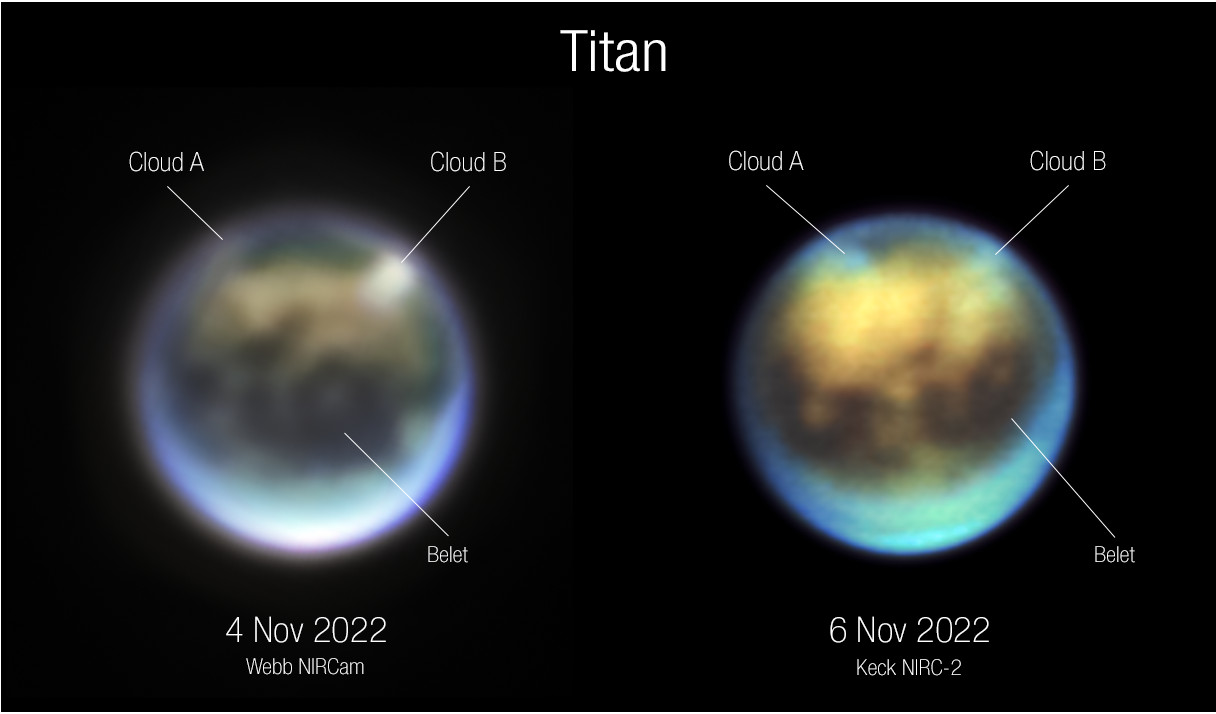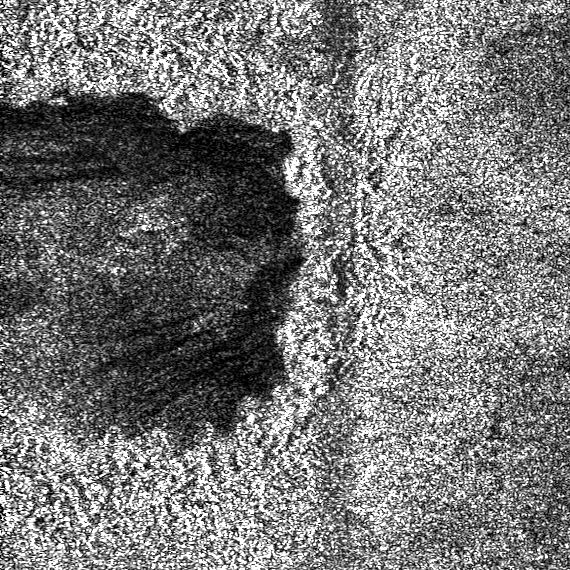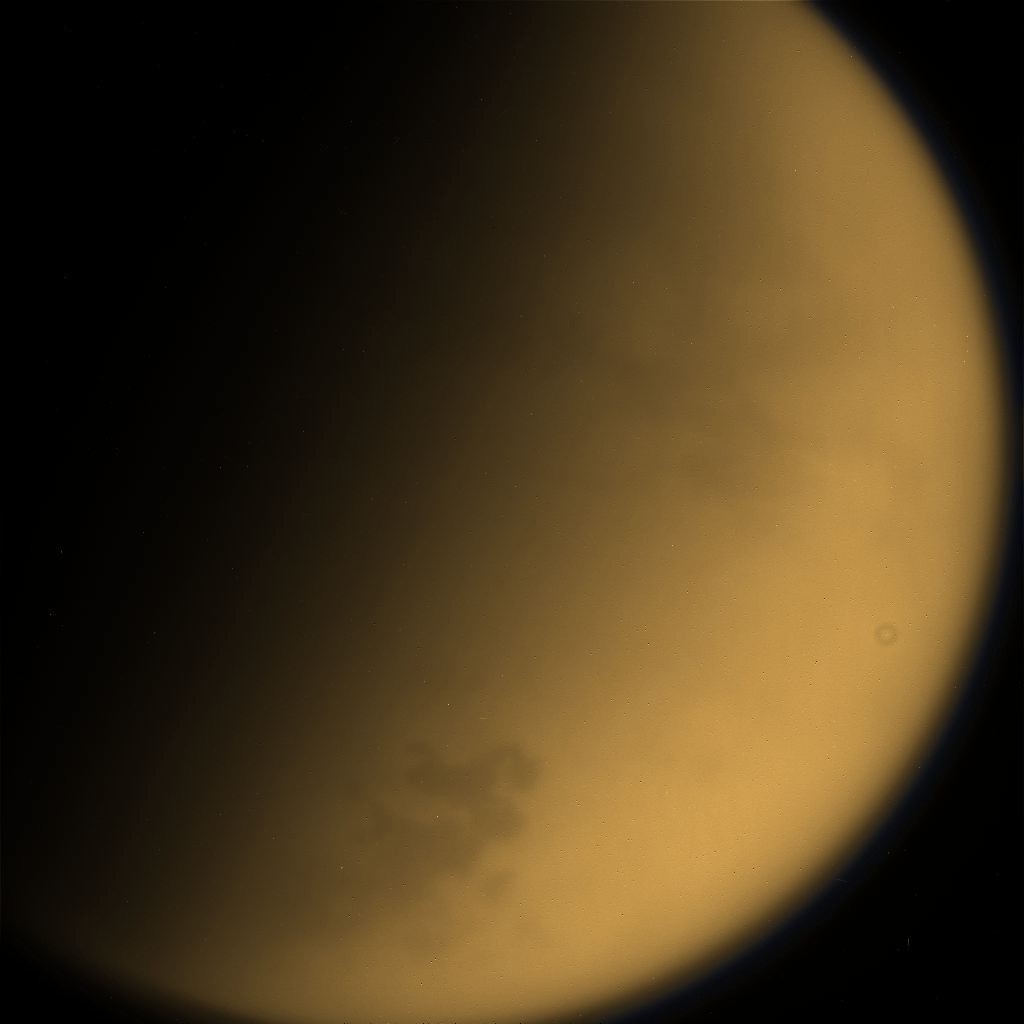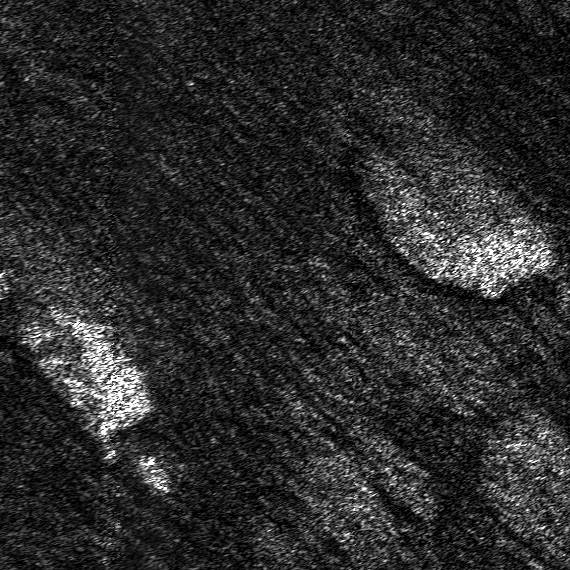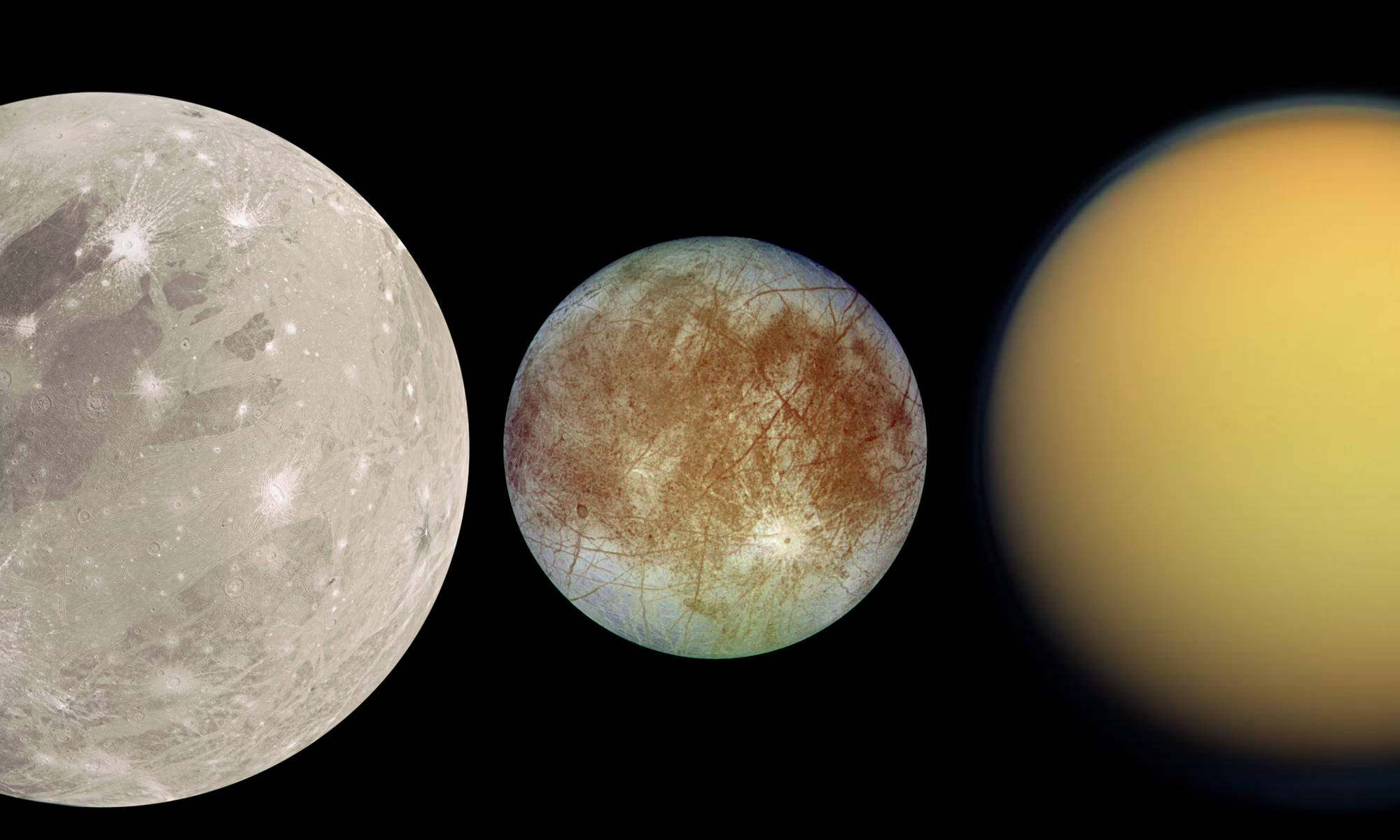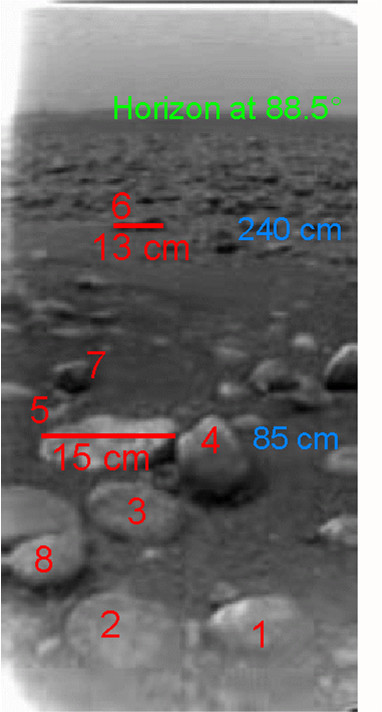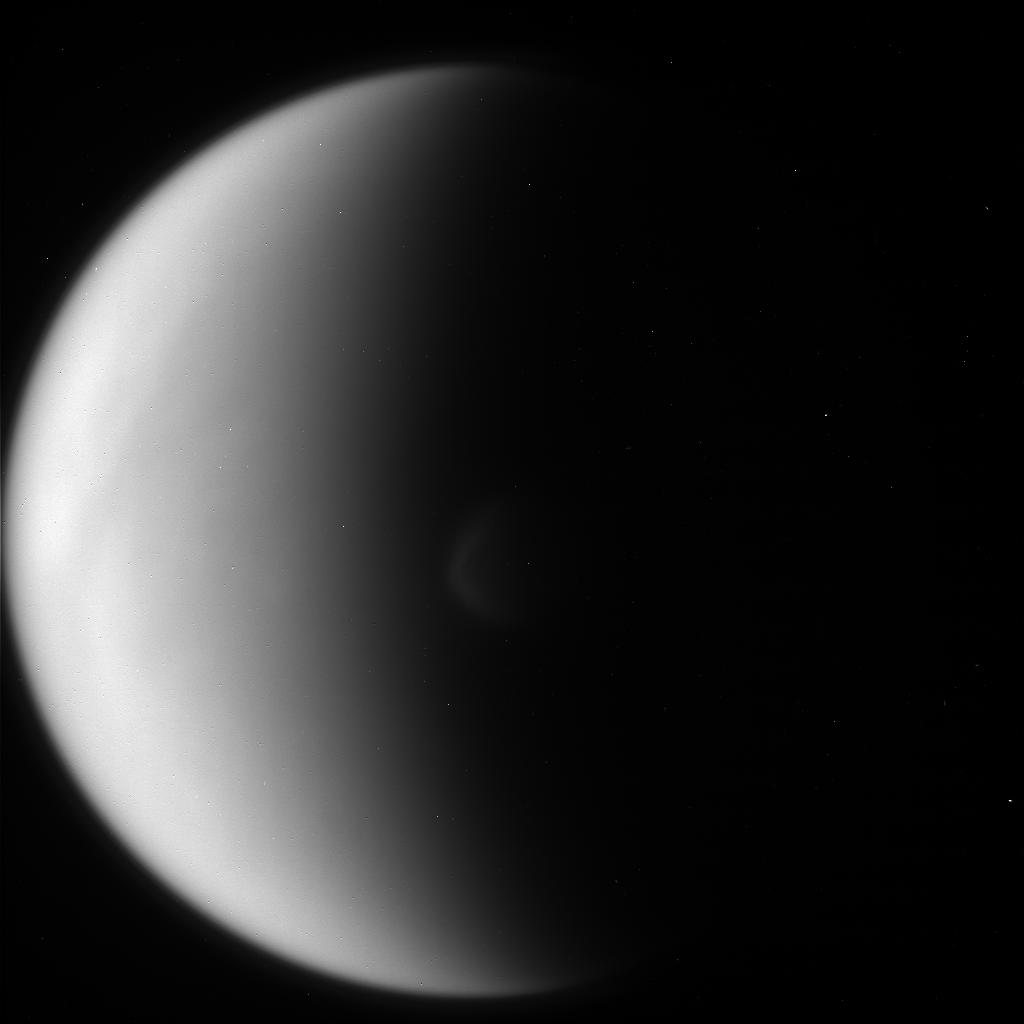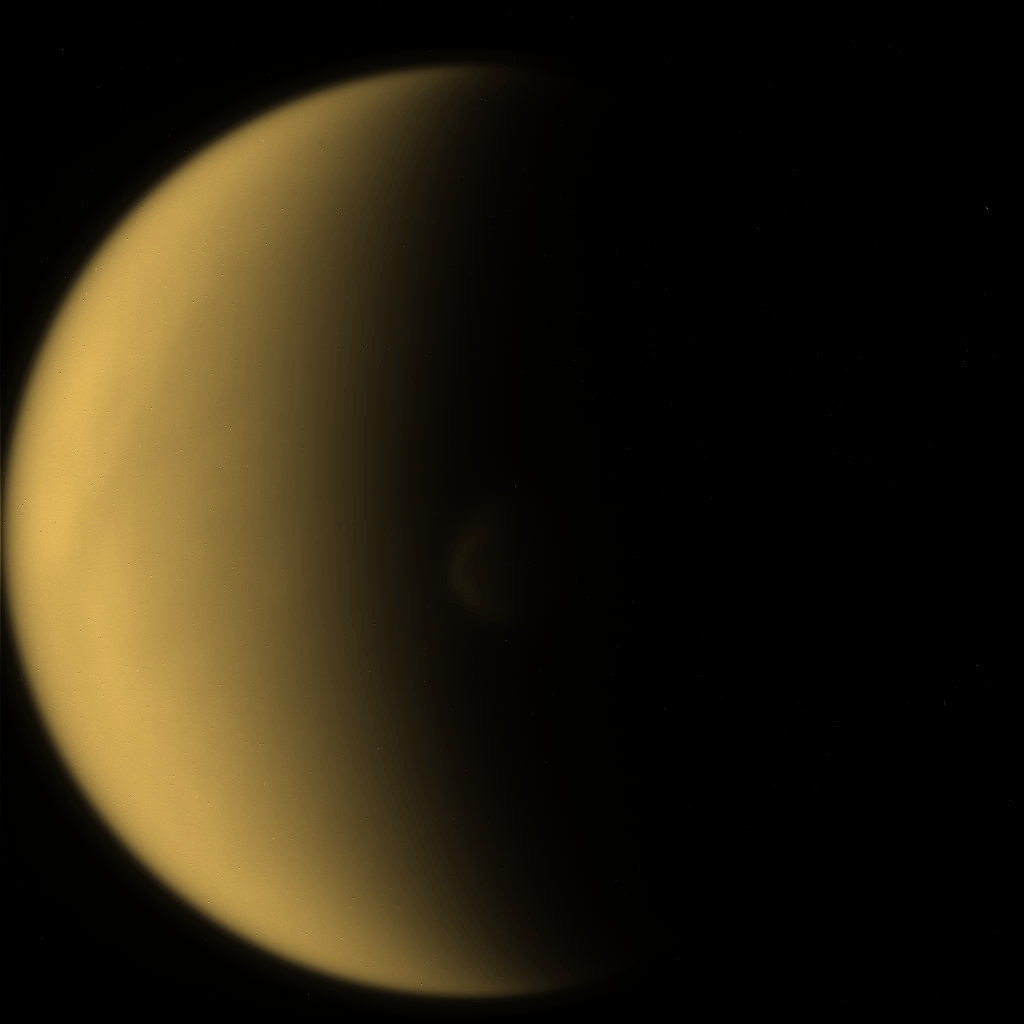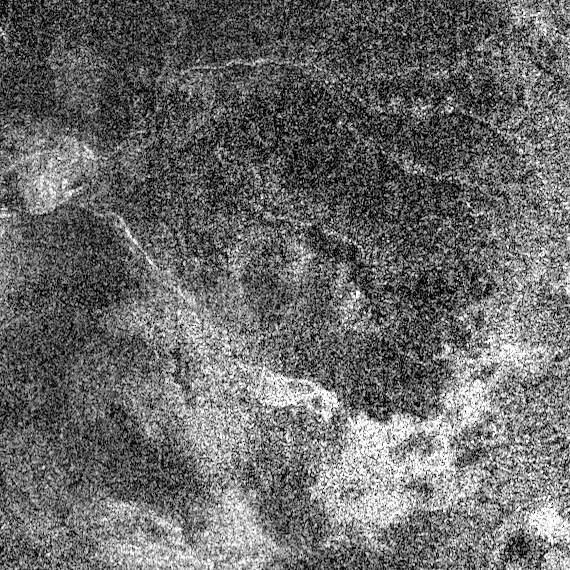Titan News 2022
December 2, 2022: Large Cloud Systems Identified On The Disk Of Titan Thanks To Data Gathered By The JWST And The Keck Telescope
The James Webb Space Telescope as well as the Keck Telescope have recently obtained new views of the disk of Saturn's largest moon Titan. Those views obtained in the infrared spectrum reveal surface features as well as major clouds in the upper part of the disk. Those clouds bring clues to the complex meteorology of that intriguing world whose atmosphere appears completely opaque from outer space. The infrared or near-infrared eyes of the JWST and of the Keck Telescope can unveil key features regarding the surface of the Orange Moon and regarding the meteorology of that giant moon. Titan has been intensively studied during the Cassini-Huygens mission in the Saturn System from 2004 to 2017. Thanks to radar data and infrared or near-infrared data captured with the eyes of the Cassini spacecraft, we know, now, that there are lakes, seas and rivers on Titan. A probe known as the Huygens probe had performed a parachuted descent into Titan's atmosphere on January 14, 2005 capturing several panoramic images of the landscape. The parachuted descent was carried out at a low latitude in the southern hemisphere in the area of Shangri-La and Adiri.
The aerial views acquired from the Huygens module during the atmospheric plunge clearly showed a major contrast between relatively bright hills and a relatively dark plain. The bright hills contained a network of dark channels that may represent drainage channels related to heavy rainfall events that must be quite scarce in the low or middle latitudes. In the harsh environment of Titan, water can only be present in its solid form or in the form of water ice on the surface. The stable pools or rivers present on the surface of Titan must be dominated by methane, ethane or propane because those molecules can appear in their liquid form on the surface. The radar images taken from the Cassini orbiter during its long mission in the Saturn System have revealed that the pools or rivers tend to be concentrated in the high latitudes or in the polar area of each hemisphere. The composition of the pools or rivers can vary depending on the latitude, on the area or on the season. Planetologists believe that the pools of that surprising world are generally composed of a mixture of methane, ethane and dissolved nitrogen. Those pools can engender clouds via typical evaporation processes.
October 1st, 2022: A New Study Reveals The Potential Topography And The Potential Properties Of The Terrain In The Selk Crater Area On Titan
A new research work entitled "Composition, Roughness, and Topography from Radar Backscatter at Selk Crater, the Dragonfly Landing Site", published on August 29, 2022 in The Planetary Science Journal and proposed by a group of researchers involving Léa E. Bonnefoy and Alexander G. Hayes reveals the potential characteristics of the terrain in the area of the Selk Crater on Titan thanks to the large amount of radar data obtained from the Cassini spacecraft during its long mission in the Saturn System from 2004 to 2017. The Dragonfly mission will involve a rotorcraft that will explore the area of the Selk Crater in the 2030s. The touchdown in the area of the Selk Crater is expected to occur in 2034 since the launch of the probe from Earth is scheduled to take shape in 2027. A major goal for mission planners is to make sure that there is a perfect landing phase. That's why an in-depth analysis of the potential topography of the terrain and of the potential properties of the surface must be performed by planetologists. Researchers can analyze infrared or near-infrared data as well as radar data acquired from the Cassini spacecraft during its long mission in the Saturn System in order to anticipate the potential configuration of the landing site.
The Dragonfly rotorcraft is expected to land at a relatively low latitude in the area of the Selk Crater. The researchers know that the equatorial area unveils an hummocky terrain or a knoll-like landscape. They can base their analyses on the Cassini radar images that can bring major clues regarding the topography, the nature or the composition of the surface. Thanks to the Radar Mapper of the Cassini orbiter, we have realized that the relatively dark areas of the low or middle latitudes tend to be dominated by linear and parallel dunes extending over long distances. The rotorcraft of the Dragonfly mission will have the opportunity to explore those exotic dunes. The team of Léa Bonnefoy analyzed radar reflectivity and angled shadows to deduce the potential properties of the surface. The planetologists anticipate that the probe will evolve in an environment composed of sand dunes and of broken-up ice. Léa Bonnefoy who is a post-doctoral researcher pointed out: "Dragonfly - the first flying machine for a world in the outer solar system - is going to a scientifically remarkable area." What types of hydrocarbons or organics will we find on the surface or in the air ?
September 15, 2022: The Discoveries On Titan Made Possible By The Cassini-Huygens Spacecraft Allowed Us To Identify A New Dimension Of Nature In The Universe
The long exploration campaign of the Cassini-Huygens spacecraft in the Saturn System from 2004 to 2017 has allowed us to perform major discoveries regarding Titan, the largest moon of the Ringed Planet Saturn, in particular. The opaque atmosphere of that intriguing world prevents us from discerning surface features in the visible spectrum from outer space. The Pioneer 11 spacecraft, the Voyager 1 spacecraft and the Voyager 2 spacecraft had not been in a position to identify surface features during their flyby due to that opaque atmosphere. Planetologists realized that Titan is a really particular moon that deserves an ambitious mission to study it from the atmosphere to the surface or the underground. They suspected the presence of oceans or seas rich in methane or ethane on the surface of the Orange Moon Titan. Thus, NASA and ESA in particular collaborated to realize a complex mission to study Saturn, Titan and the other moons of the Gas Giant. The engineers and the researchers of the mission developed the Cassini-Huygens spacecraft. That spacecraft lifted off in 1997 for a long trip to the Saturn System. The Saturn Orbit Insertion (SOI) occurred in 2004.
The spacecraft used the gravitational forces of Saturn and the numerous moons to perform a multitude of flybys of the Ringed Planet, Titan and the other neighboring moons. The Cassini-Huygens spacecraft performed a multitude of elliptical orbits in the Saturn System during its long mission. The Cassini-Huygens spacecraft contained a module to explore the surface of Titan. That module was the Huygens probe. The Huygens probe performed a parachuted descent and landed on that intriguing world on January 14, 2005. The aerial views acquired during the atmospheric descent revealed surface features resembling Terrestrial landscapes. One could notice bright hills containing a network of dark channels as well as a brown or dark plain that looked like a dried-up sea. The dark channels are likely drainage channels related to meteorological phenomena. They seemed to be dry during the parachuted descent. Some researchers and some individuals in the general public had drawn a parallel between the images of the landscape of Titan acquired during the parachuted descent and the images of the French Riviera from a plane approaching the airport of Nice.
June 6, 2022: A New Study Brings A New Light On The Potential Formation Mechanisms Of Sand Dunes On Venus, Mars, Titan, Triton Or Pluto
A new research work entitled "Conditions for aeolian transport in the Solar System", published in Nature Astronomy and proposed by Andrew Gunn and Douglas J. Jerolmack reveals the various potential formation mechanisms of the sand dunes encountered on several worlds of the Solar System. Worlds like Venus, the Earth, Mars, Titan or Pluto unveil systems of dunes whose formation mechanisms can be different due to physical parameters or local conditions. The gravity, the composition of the crust or the density of the air at sea level can have a significant impact on the topography or on the nature of the soil. Relatively strong winds that exceed threshold speed can engender sand dunes if the grains are sufficiently strong to keep their shape in any collision event. Most moons of the Solar System are devoid of any significant atmosphere so that the surface is dominated by impact craters. The Terrestrial worlds or the icy worlds that contain a relatively significant atmosphere must have sand dunes. That's the case for Venus, the Earth, Mars, Titan and Pluto. Triton, the largest moon of the Gas Giant Neptune, may also contain vast fields of sand dunes but the resolution of the surface obtained thanks to data captured from the Voyager 2 probe is too low to confirm that strong hypothesis.
The threshold theories that are available today tend to neglect physical processes. Yet, physical processes must be taken into account for extraterrestrial worlds. Therefore, the theories on the mechanics of sand dune formation must be revised or refined on the basis of other parameters and on the basis of the new clues we regularly obtain in planetary exploration. The planetologists analyzed the results in contact, rarefied gas, statistical and adhesion mechanics in order to propose a theory for the fluid and impact thresholds of aeolian movement that is in line with the various environmental configurations encountered in the different worlds of the Solar System. The predictions of the theory are in line with available experimental threshold observations and show that these thresholds are closely related to local environmental conditions on the various extraterrestrial worlds found in our planetary neighborhood. The outcome of the research work reveals that the dunes found on Titan must be locally sourced and that the high threshold of the Red Planet Mars makes its dunes less unstable or more resistant to movement. The large-scale views tell us a lot regarding the dynamics of the dunes.
May 6, 2022: New Experiments Reveal The Potential Freezing Point Of Subsurface Oceans Like The Potential Subsurface Ocean Of Europa Or Titan
A new research work entitled "On the pressure dependence of salty aqueous eutectics", published on April 12, 2022 in Cell Reports Physical Science and proposed by a team of researchers involving Baptiste Journaux reveals the potential limits of subsurface oceans like the potential subsurface ocean found beneath the crust of several icy worlds present in the Outer Solar System. Moons like Europa, Ganymede, Mimas, Tethys or Titan may contain a subsurface ocean beneath their external crust. If the subsurface ocean is dominated by water, one has to determine the potential limits of that ocean or the right combination of pressure and environmental temperature to allow the stable presence of a liquid layer beneath the external crust. The level of pressure above the potential subsurface ocean must be extreme so that any potential liquid can remain liquid even if the environmental temperature is extremely low. The presence of salt in the liquid dominated by water makes the freezing point of the liquid lower and a higher level of pressure can lower the freezing point of the potential liquid. How deep will we have to dig in order to reach the potential subsurface ocean inside Europa, Ganymede or even Titan ?
The new experiments upon the physical limits of any potential subsurface ocean were led by scientists from the University of Washington and from the University of California, Berkeley. The identification of any potential subsurface ocean in the Outer Solar System is fundamental in terms of exobiology in particular. The potential subsurface ocean can be in direct contact with the surface like on the tiny moon Enceladus, a surprising world evolving around the Gas Giant Saturn. There are geysers in the fractures of the south polar region of Enceladus. Those geysers demonstrate that a subsurface ocean dominated by water is clearly possible. Tidal forces must play a key role in the level of stability of the potential subsurface ocean. Baptiste Journaux who is an acting assistant professor of Earth and space sciences at the University of Washington pointed out: "The more a liquid is stable, the more promising it is for habitability." He added: "Our results show that the cold, salty, high-pressure liquids found in the deep ocean of other planets' moons can remain liquid to much cooler temperature than they would at lower pressures. This extends the range of possible habitats on icy moons, and will allow us to pinpoint where we should look for biosignatures, or signs of life."
April 26, 2022: A New Research Work Reveals The Potential Sedimentary Cycle Of Titan
A new study "entitled "The Role of Seasonal Sediment Transport and Sintering in Shaping Titan's Landscapes: A Hypothesis", published on April 1st, 2022 in Geophysical Research Letters and proposed by a team of researchers involving Mathieu Lapôtre from Stanford University brings us key information regarding the various potential formation processes of the landscape of Saturn's largest moon Titan. The research work unveils a model that can help us better understand the sedimentary cycle of the giant moon. There are clearly some similarities between the landscape of Titan and the landscape of the Earth even if the molecules involved at the level of the surface of Titan and at the level of the surface of the Earth can be radically different. The atmosphere of Titan, dominated by molecular nitrogen like the atmosphere of the Earth, contains a relatively significant fraction of methane. In the harsh environment of Titan, methane can form rivers, lakes and seas in the high latitudes of each hemisphere. Methane can also form clouds that can engender rainfall events on that giant moon. The exotic meteorology of Titan can appear familiar to us to a certain extent. Water can be present on Titan in its solid form due to the extremely low environmental temperature at the level of the surface.
The relatively dark areas found in the low or middle latitudes of Titan tend to be dominated by Seif Dunes or linear and parallel dunes extending over long distances. The shape of those dunes is closely linked to prevailing winds. The composition of the Titanian dunes can appear really exotic since they must be dominated by hydrocarbons or organics. The chemistry and the dynamics of the Titanian dunes must be quite different from the typical dunes we regularly encounter on Earth. The mean density of the dunes found on Earth must be much higher than the mean density of the dunes found on Titan. On the Blue Planet, the dunes will tend to be rich in silicate-based substances whereas they will tend to be rich in carbon-based substances on the Opaque Moon. The team of Mathieu Lapôtre has managed to determine the processes that can lead to the formation of the dunes, the formation of the sand grains or the formation of the bedrock one can find on Titan. Winds, rainfall events and streams flow play a key role in the various potential processes leading to the landscape one can see today. Several types of landscape features can be identified on the Orange Moon, from dunes to plains, lakes, seas or labyrinth terrains.
February 22, 2022: A New Study Reveals How The Radiative Heating Of The Haze Of Titan Engenders A Superrotation Of Its Stratosphere
A new research work proposed by Motoki Sumi, Shin-ichi Takehiro, Wataru Ohfuchi, Hideko Nomura and Yuka Fujii, entitled "Superrotation of Titan's stratosphere driven by the radiative heating of the haze layer" and published in Arxiv shows the influence of the radiative heating of Titan's haze layer on the superrotation phenomenon of its stratosphere. The atmosphere of Saturn's largest moon is known to move faster than its surface. A phenomenon of superrotation is observed for the atmosphere of Titan or for the atmosphere of Venus. Both worlds contain a completely opaque atmosphere that prevents us from discerning surface features in the visible spectrum from outer space. The atmosphere of Titan is extremely cold whereas the atmosphere of Venus is extremely warm but the dynamics of both atmospheres presents some similarities. The atmosphere of the Opaque Moon rotates many times faster than its surface does for instance. That's also the case for Venus where the surface rotates extremely slowly compared to the surface of the Earth for instance. The atmosphere of Titan is particularly complex with a multitude of layers in its outer limits and with a thick haze layer containing various molecules like hydrocarbons or organics. The dynamics and the composition of that haze layer are closely related to solar radiations.
The researchers of the new study carried out numerical experiments mobilizing a General Circulation Model (GCM) to determine or evaluate the effects of the haze layer on the stratospheric superrotation. They resorted to a semi-gray radiation model of the atmosphere of the giant moon of Saturn following McKay et al. (1999) which incorporates the factor of sunlight absorption by haze particles. The simulations of the team did not incorporate the factor of the phase change of methane or the factor of the seasonal changes. The model based on the action of solar radiations on the thick haze layer of the Opaque Moon produced a configuration in which there is a global eastward wind around the equator with higher speeds at higher altitudes except at about 70 kilometers above the ground after 10^5 Earth days. The model predicts zonal wind profiles that are in line with the observations of that type of phenomenon even if the atmosphere does not appear to be in an equilibrium state. The analytical work of the team in its experiments implies that the quasi-stationary stratospheric superrotation is stabilized by the balance between the meridional circulation disconnected from the surface and the eddies that push angular momentum towards the equator.
February 19, 2022: A New Study Reveals That Craters Whose Diameter Is Smaller Than 50 Kilometers Tend To Completely Disappear Due To Erosion Over Geologic Time Scales On Titan
A new research work entitled "Crater production on Titan and surface chronology", proposed by N.L. Rossignoli, R.P. Di Sisto and M.G. Parisi and published in Arxiv reveals the key action of erosion on relatively small craters on Saturn's largest moon. Big craters whose diamater is over 50 kilometers can persist or can be well discerned over the Solar System age whereas smaller craters tend to completely vanish due to the erosion processes related to winds, rainfall events or even snowfall events. Titan is the only world evolving around the Gas Giant Saturn that contains a significant atmosphere implying a relatively strong action of erosion on its surface. The other moons of Saturn contain numerous craters that are likely to allow us to determine the potential age or history of those worlds. Worlds like Tethys, Dione or Rhea are rich in impact craters on their bright surface likely rich in water ice. The researchers can analyze those craters in order to deduce the age of the crust or surface. They are in a position to determine constraints on the population of the impactors that can be comets or asteroids. Regarding the impactors, the planetologists focus their attention on centaur objects or objects that evolve in the area of the Gas Giants.
During the long Cassini-Huygens mission in the Saturn System, from 2004 to 2017, the Cassini orbiter has captured a huge amount of data regarding the surface of the giant moon. We have collected images obtained in the infrared or near-infrared spectrum as well as radar images so that the surface could be discerned despite the presence of a completely opaque atmosphere in the visible spectrum. Researchers have had the opportunity to evaluate the concentration of potential impact craters on that exotic world and it turns out that impact craters are remarkably scarce despite a relatively dry environment in the low or mid-latitudes. The relatively big craters can appear strongly degraded or eroded. The planetologists mobilized the previous research works on impact cratering rates on the various moons of the Ringed Planet Saturn and modeled the cratering process on the Orange Moon to constrain the surface chronology of that world and to evaluate the role of centaur objects that are considered the main impactors of Saturn's largest moon. The Outer Solar System is far from being empty in terms of asteroids, comets or even Dwarf Planets. Numerous objects can be identified between Jupiter and Neptune.
January 14, 2022: A New Study Reveals That The Haze Particles Of Pluto Are Bimodally Distributed And Confirms The Key Role Of Photochemistry In The Formation Of The Upper Haze Of Titan
A new study entitled "A bimodal distribution of haze in Pluto's atmosphere" and proposed by a team of researchers involving Siteng Fan and Peter Gao reveals that the haze particles of the Dwarf Planet Pluto are bimodally distributed and that the formation of the upper haze of the giant moon Titan is apparently related to photochemical phenomena. Several worlds of the Outer Solar System contain atmospheres that look alike to a certain extent. Those worlds are Titan, Triton and Pluto. Their atmosphere unveils a haze that is closely related to the action of the light emitted by our star the Sun. The atmosphere of Titan is completely opaque and is particularly deep and thick. On the other hand, the atmosphere of the largest moon of Neptune Triton and of the biggest Dwarf Planet Pluto is very thin with a very limited atmospheric pressure on the surface. The atmosphere of the three worlds is dominated by molecular nitrogen like the atmosphere of our own planet. One can notice that the atmosphere of Mars or Venus is part of another category of atmospheres since the atmosphere of both worlds is dominated by carbon dioxide rather than molecular nitrogen. However, molecular nitrogen appears to be the second most abundant compound of the atmosphere of those worlds.
The atmosphere of Pluto or Triton can be compared to the upper atmosphere of Titan where photochemistry tends to play a key role. In the upper atmosphere of the largest moon of the Ringed Planet, several atmospheric layers can be discerned. That's also the case in the atmosphere of Pluto which had been clearly observed from the New Horizons spacecraft during its historic flyby of Pluto and Charon on July 14, 2015. The icy or rocky worlds of the Outer Solar System tend to be rich in molecular nitrogen, carbon monoxide, methane or water ice. A molecule like methane can appear in its solid form on the surface of Triton or Pluto whereas that molecule appears as a gas in the typical environment of the Earth. Methane can also form clouds in the atmosphere of Titan. Rainfall events can be encountered on Saturn's largest moon. Therefore, rivers, lakes or seas can be encountered on that enigmatic world. On Pluto or Triton, the atmosphere is too thin for the presence of liquid methane or liquid nitrogen on the surface. A heavier atmosphere is needed on Pluto for the formation of lakes or seas of nitrogen. Strong cryovolcanic events on Pluto may allow the presence of transient lakes or rivers of nitrogen from time to time.
Titan News 2021
Titan News 2020
Titan News 2019
Titan News 2018
Titan News 2017
Titan News 2016
Titan News 2015
Titan News 2014
Titan News 2013
Titan News 2012
Titan News 2011
Titan News 2010
Titan News 2009
Titan News 2008
Titan News 2007
Titan News 2006
Titan News 2004, 2005
Back to Main Page
